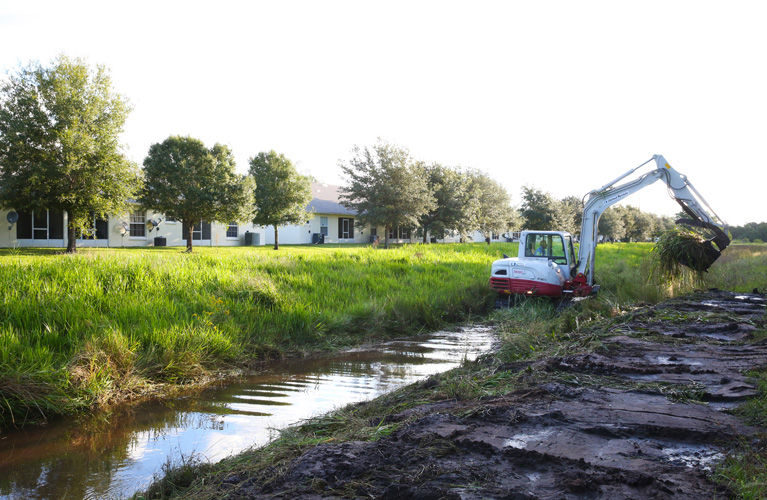
SEBASTIAN — Sebastian City staff made good on promises made several weeks ago and cranked up work on clogged drainage ditches, responding to recent heavy rains, the potential for major roadway damage, and citizen complaints about flooding.
During every rainy season, City staff and Council members are “flooded” with drainage complaints from citizens.
Council member Andrea Coy has said that she, along with other residents, have felt “pushed aside,” because long-standing drainage issues in her neighborhood remain unaddressed.
“I’ve had wet feet for 10 years,” she says.
Coy receives numerous calls from residents who also have wet feet.
Among the comments she’s heard and passed along to City staff: “I have to wear boots to get my mail and to take out the garbage,” “I need to replace my driveway but I can’t until the drainage problems are fixed,” and “I think the City’s just forgotten about me.”
Griffin and Watanabe have given residents assurances that no one will be forgotten.
At the Oct. 8 City Council meeting, City Manager Joe Griffin and City Engineer Frank Watanabe assured residents and Council that ditch clearing work, long postponed as budget and staff constraints and other must-do projects took precedence, would now be moved to Priority 1.
The following day, it was.
City Stormwater Superintendent Tim Walker currently has six workers and two supervisors hard at it.
Three excavators – one city-owned, two rented at $2,600 a month each – are all running, in different parts of the city, working to clear the 50 miles of rear ditches that receive water from the front swales.
Walker, who’s been with the City for 23 years and is familiar with the drainage system, says that, contractor John Conlon cuts the slopes three times a year, but the ditches themselves “are totally clogged with vegetation. Because of the various constraints and cutbacks, it’s been a good nine years since we’ve been in there.”
The non-functioning ditch system, combined with the heavy rains that always assail the area this time of year, result in flooding of streets, swales, yards, driveways and roadways, and can also, eventually, cause damage to road surfaces.
At the Oct. 8 meeting, Watanabe warned Council, “If it keeps flooding, the water will damage the asphalt.”
“With those three (excavators) running, everything – the main ditches – from Barber Street to the west is opened up. We’ve got another machine off Schumann, from the tennis courts toward the school – Pelican Island Elementary. We’re tying up loose ends, then Monday we’ll have the machines over on the other side of Barber, around George Street by the Englar Street Bridge.”
Walker estimates the main ditches should be finished by the first of the year, and Griffin says the work will continue through the dry season.
“We’re out there – rain or shine,” Walker says.
According to City Engineer Frank Watanabe, some of the worst flooding occurs along Rolling Hills and Benedictine streets, off of Barber, an area with a long history of drainage problems.
The cross streets in that area, Damask and Melrose and portions of Concha and Periwinkle, are longtime problem areas as well.
In the southwest end of the city, says Watanabe, all the stormwater drains toward the main ditch, into the Stonecrop retention area.
In order for this crucial drainage network to function properly, the ditches must be free of debris.
Closer to City Hall, across from Sebastian Elementary School, and along Delaware near George Street is another bad drainage area.
Here, says Watanabe, streets often flood, however, the homes themselves never have been threatened. Ironically, he says, this is because the houses are on septic systems and, therefore, are built 2-3 feet higher than the crown of the road, one of the few positive aspects of a septic tank system.
Unlike many other cities, “We rarely have to use sandbags. The roads will turn into canals before the homes will flood.”
Watanabe reiterates what he’s said frequently about water damage to roadways, asphalt in particular.
“Asphalt doesn’t do well with standing water. Two or three days under water will damage the asphalt. It is real critical to get the water off the roadways before doing any road improvements.”
The City, he continued, is in the process of purchasing a replacement vac truck.
The current 14-year-old vacuum truck is on its last legs, virtually “held together by Band-Aids,” and in use almost daily, all over town, sucking water out of ditches and manholes.
It is also needed to help maintain the City’s baffle boxes.
Such a vehicle, which Watanabe describes as very similar to a fire engine, costs about $18,000 a month to rent. The City plans to use a state contract to purchase a new $400,000 vac truck, an item already approved in the current budget.
Such equipment cannot be bought “off the shelf,” but will take three to four months to build, Watanabe says, and should be in-house in time for the 2015 rainy season.
Meanwhile, “We’ll continue limping along with the old vac truck,” he says.
Another related issue that has received considerable recent attention concerns the seawalls along the Elkam Canal and the residential properties they protect.
“We know of at least three which are failing,” says Watanabe.
The City has surveyed the properties and is in the process of making an assessment to determine the best way to address the problem.
The seawalls are very old, placed many years ago by General Development, and several, at least, are on the property owners’ land, not the city’s rights-of-way.
About four or five years ago, Watanabe said, the city, through a federal grant, completed a major $4 million project to repair seawalls and dredge the Collier Canal all the way from the Hardee Park Dam to County Road 512.



